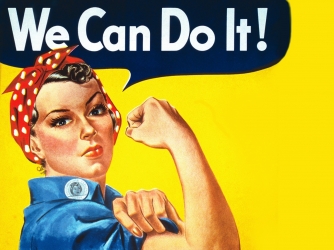Women History Spotlight: Rosie the Riveter

Rosie the Riveter is an American icon that symbolizes the female workforce aiding in the war effort.
March 8th, 2017 marked International Women’s Day—a holiday dating back to 1911 which celebrates women who have made a difference in American history. Rosie the Riveter was one of these important women. She played a large role in the fostering of a new wave for the Women’s Movement in the mid-20th century.
In 1942, Westinghouse Electric Corporation hired artist J. Howard Miller to create series of posters with the end goal of encouraging employees in the wartime workforce. Miller’s posters originally did just that–encouraged a greater work effort.
However, one image in particular struck a chord with American women and later became the symbol of a new generation of feminists. Miller’s “We Can Do It!” poster later adopted the name “Rosie the Riveter” from Norman Rockwell’s cover for The Saturday Evening Post in 1943.
Making her mark on history from the walls of the Westinghouse Electric and Manufacturing Company, Rosie the Riveter, although just a poster, played an essential role in motivating the female workforce to aid in the war effort by filling recently vacated job positions during World War II.
Rosie’s encouragement spread far beyond the time of WWII, spanning from solely encouraging work to encouraging a generation of women. Although women had already won suffrage around twenty years prior, Rosie’s image reignited the fight for women’s rights–introducing the Liberation period which encompassed myriad social inequalities like those within familial roles, reproductive rights, and working wages.
Rosie stood as a popular icon of the time–her image maintaining its significance even today–and fully embodied the image of the working woman and promoted the fight for further women’s rights.






